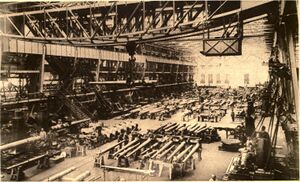Labour and Unionists Cooperative
Labour and Unionists Cooperative Ocisa e Uninui Cooperative | |
|---|---|
 | |
| Abbreviation | OeUC |
| Chairperson | Nicolas Jessen |
| Vice-Chairperson | Dhreja Schi |
| Founded | March 22, 1919 (as the SLLUC) |
| Legalised | July 11, 1942 |
| Youth wing | Young Labour |
| Ideology | Democratic Socialism Anti-Capitalism |
| Political position | Left wing to Far left |
| Colors | Red |
| Commons Council | 10 / 293
|
| State Council | 4 / 106
|
| State Governors | 0 / 7
|
| State Legislatures | 42 / 487
|
As one of the original political organizations in Seketan, the Labour and Unionist Cooperative (Seketese: Ocisa e Uninui Cooperative, OeUC), or more often just shortened to Labour, originated as a loose alliance of various workers unions and communist groups during the Nelbec Empire. Upon dissolution of the imperial crown, Seketan descended into political chaos, with a civil war breaking out between the Far-Left Soysmets and the Republicans, led by the Kjedorate . Labour sided with the republic, but once the war concluded, were banned and had their ranks cracked down in by the general anti-communist sentiment of the Early Republic. It wasn’t until WWII, when Seketan needed to gain favour with the USSR for supplies, that the party was finally allowed to participate in elections.
For most of the 1940’s to the 1970’s it was the dominant left wing party, always in opposition to the governing Kjedorates. It wasn’t until the rise of the more moderate and progressive Socialist Party (SY), a splinter group from Labour, in the 1970’s that the party lost favour in the minds of the electorate. The Socialist’s appealed to the more urban Seketan and pushed many long time Labour MP’s out of previously safe seats in Conelibek, Loria and Porta. Labour proved to be too big tent to adapt to the younger, more fresh party, and eventually was reduced to 3rd or 4th party after the 1980’s.
Today, the party is left wing, democratic socialist yet more traditionalist than their other left-leaning counterparts like the Green Party and the Socialists. Their voter base is largely found in old coal and iron mining towns, Trjebian speaking towns, along with the poorer neighborhoods of Conelibek and Fyedor. Voters also tend to be slightly older than the Socialists, more sceptical of the EU and more opposed to changing social tides, although the party has tried to change this culture within their members. Their current leader is Nicolas Jessen, who served as Minister of Labour in 2014.
History
Early years
The creation of the OeUC came about during the rise of other left wing movements in Europe in the mist of WWI. The authoritarian and monarchist Nelbec Empire didn't allow elections or political parties, so it started as more of a nation wide workers union under the name of Seketese Workers, Labourers and Unionist Cooperative or SLLUC. The loose group were often cracked down upon by imperial police due to their anti-war positions, which often included promoting mutinies in the ranks of the army. The organization found support quickly among those working in war time factories as imperial work standards dropped in response to a greater need for materials. While forming workers unions was illegal during this time, many factory workers found a way around it by joining the SLLUC as it wasn't technically a union and thus wasn't outright illegal. Despite pressure from authorities, the SLLUC would continue to grow in numbers up until the wars end.
During the civil war
In 1919,upon the collapse of the Nelbec Empire the SLLUC formally changed its name to the Labour and Unionist Cooperative, forming the modern political organization. In the chaos of the end of the Empire, civil war broke out in Seketan, between the Nationalist Sosyments and the Republican Kjedorates. In 1921 the OeUC formally voted to side with the Republic and fought in the new Seketese Republican Army until 1924 with the war concluding in Republican victory. Initially the OeUC thought that their war time allies, the Kjedorate Party, would keep their promises to hold free and fair elections. However come 1925 the new government was formed with the OeUC being left out of the new President Lorin Allies Cabinet. Protests against this authoritarian move rose up, leading to the Kjedorates to require all parties to pass a "Republican value test" before being allowed to run in elections. This gave them all the power to decided who can challenge them in elections, and it lead to the banning of many political parties including the OeUC.
Legalization
When Germany invaded Seketan in 1942, the weak and ineffective government of Seketan, now confined to just parts of Nelderjen, Wilskland and Bynan, pushed the Allied powers to grant them resource deals so they could continue their weapons manufacturing. The allies gave them a list of demands that they needed to meet before any deal would be struck. One of these demands, pushed hard by the Soviets, was the legalization of the OeUC and several other left wing organizations. Upon the signing of the Treaty of Fyedor on July 11, 1942, the OeUC was finally able to contest in elections legally after nearly 20 years of underground activity. For the remainder of the war, they helped participate in the temporary war cabinet of Lorin Allis, another one of the the Soviets demands. They held the positions of Labour Minister, Health Minister and for a few months, Foreign Minister. In 1945 the Germans surrendered to the Allies, finally ending the war and Seketans war cabinet and the establishment of the 3rd Seketese Republic under the rule of Lorin Allis.
Under the Third Republic
Despite being legalized and allowed to run in elections, the Kjedorates still held a monopoly on power. In several elections with questionable transparency, Lorin Allis was able to maintain a super-majority of seats in the Hérvynsken and faced minimal oppostion.
